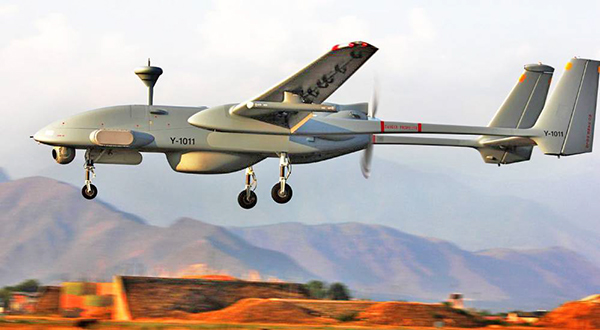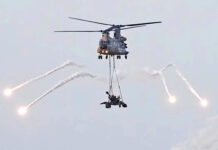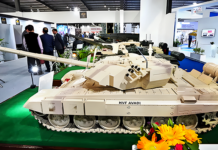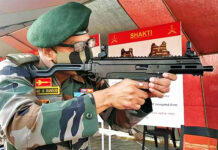The Defence Acquisition Council (DAC) of the Ministry of Defence (MoD) gave its go-ahead, on 11 August 2020, for the purchase of equipment worth Rs 8,722.38 crore, which included 106 Basic Trainer Aircraft (HTT-40), 125-mm tank ammunition for the Army and upgrading part of the fleet of the Israeli Heron UAVs to carry bombs and air-to-ground missiles under Project Cheetah.
Project Cheetah
The unmanned aerial project – code-named Project Cheetah – is for arming Heron UAVs with laser-guided bombs, precision-guided munitions and anti-tank missiles. Project Cheetah has been pending for a long time and now the three Services have decided to revive it. It is likely to cost the exchequer over Rs 3,500 crore. The armed forces have pressed for equipping 60-90 drones with stronger surveillance and reconnaissance payloads to keep an eye on the enemy and take them out if and when needed. The Air Force will have join hands with the Israel defence major Israeli Aerospace Industries (IAI) for the modifications.
The upgrades would also enable the IAF ground station handlers to operate these aircraft from far-off distances and control them through satellite communication system.
The decision to revive the ‘Project Cheetah’ has been taken in view of the recent border standoff with China along the Line of Actual Control (LoAC) in eastern Ladakh.
The upgraded UAVs can be used against conventional military operations as well as in counter-terrorism operations in future, if required. With such a capability in its fold, in future scenario if the Army units inform about any particular launch pad of terrorists getting active, the Indian Air Force (IAF) can deploy its armed drones to unleash a silent punishment to terrorists from 30,000 feet over the ground.
With the upgrade in reconnaissance capabilities, the forces on the ground would also be able to get pin-point intelligence about hideouts in areas where men have to be involved in operations.
The upgrades would also enable the Armed forces’ ground station handlers to operate these aircraft from far-off distances and control them through the satellite communication system. The precision guided missiles would also help in specific elimination of desired targets and there would be none or minimum collateral damage in such operations.
After silently hovering over Pakistan Occupied Kashmir (PoK) over suspected launch pads for some time gathering accurate intelligence the drones can launch an attack and return to the base causing greater damage than what the troops can do.
For turning their surveillance drones into killer vehicles, the IAF has taken a cue from the United States. For the Americans, drones are the weapons of choice for taking out terrorist leaders or destroying their safe houses. The Americans regularly smoke out terrorists using their MQ-1 Predators and Global Hawk as it has killed several more than 2,500 terrorist leaders in Afghanistan and Pakistan alone during its war on terror in these countries.
Current Holding
The Indian armed forces, so far, do not have drones which can fire ammunition from air. However, they do have “kamikaze drones” – Harop — which can hover over a target. On command from a ground-based controller, they can self-implode on the target.
The Heron drones with the IAF and Army have high-resolution surveillance cameras and electronic signal tracking systems, but their operating system will have to be modified for hitting targets.
The current holding of medium and high-altitude UAVs is as follows:
Heron 68
Searcher Mk 2 108
Harop (Harpy 2) 10
Nishant 12
The cost of each imported bird varies from Rs 48 to 80 crores. Nishant is believed to cost about Rs 20 crore. In comparison the Tejas LCA Mk 1 cost Rs 445 crore and a Su-30MKI costs about Rs 360 crore.
The cost of an drone modified to fire missiles is likely to be over Rs 100 crore each.
DRDO’s Efforts
The Defence Research & Devlopment Organisation (DRDO) is currently developing the Rustom-1 (12 hours endurance), Rustom-H (24 hours endurance) and Rustom-2 (TAPAS 201) (48 hours endurance) drone. For Rustom-2 nearly Rs 1500 crore have been spent so far. It is now intended to involve the private sector with its development.
Rustom-2 has received additional funding and is being developed for intelligence, surveillance & reconnaissance (ISR) roles with medium and long-range electro-optics, synthetic aperture radar (SAR), ELINT, COMINT payloads to provide situational awareness.
DRDO is also developing the 15-ton Aura UAV as a combat drone.
The main private players in this field are Larsen & Toubro, Tata Defence & Aerospace, Mahindra Defence, Bharat Forge, Data Patterns, Alpha Design, Dynamatic Technologies, Adani-Elbit JV, Asteria Aerospace and Alpha Design & Technologies.
In February this year, drones’ manufacturer Israel Aerospace Industries (IAI) had announced a strategic partnership with public sector undertaking Hindustan Aeronautics Limited (HAL) and Dynamatic Technologies Limited (DTL) to jointly manufacture Heron Mk II drones. These are the armed variety. The ones India is looking to upgrade could possibly be done through the same partnership.
Challenges
Combat drone are expected to be autonomous with the ability to find, fix, track, engage and kill targets. For this they need to have the right propulsion, avionics, navigation systems, sensors and payloads. For medium altitude long endurance (MALE) UAVs engines of the Wenkel type (20-100 hp) and for the high altitude long endurance (HALE) UAVs, turbofan or turboprop engines (250-1000 hp) are required.
Designers, developers and manufacturers have to overcome challenges related to composites, aerodynamics, communication systems, embedded software, weapon systems, control mechanisms and so on.
Technology gaps that exist in India are to do with electro-optics (thermal cameras, FLIR), propulsion motors, high density Lithium batteries required for robotic systems, and so on.
Comments
The Chinese are arming Pakistan and their friends in the Middle-East with Wing Loong-1 and-2 armed UAVs, many of which are copies of American armed UAVs.
According to a January 2020 report by SIPRI, China is the second largest arms producer and its exports are helped by major sales of combat drones. China is today the third largest exporter of multi-role strike drones after Israel and USA.
The Chinese have sold armed drones to UAE, Saudi Arabia, Egypt, Algeria, Ethiopia, Iraq, Jordan, Myanmar, Nigeria, Turkmenistan and Zambia.
USA used Predator and Reaper drones to good effect in its war against terrorism in Syria, Iraq, Libya and Yemen. It accounted for over 2,500 terrorists killed in Afghanistan and Pakistan. The UAE has used Chinese Wing Loong-1 drones in Yemen and Libya. Turkey has used its own armed drones in Libya and against the Kurds. Yemeni Houthi rebels used the Qasef-1 kamikaze drones and the UAV-X (Samad-2/3) drones along with Iranian Quds cruise missiles to attack Aramco Oil refinery in Saudi Arabia on 14 September 2019.
The surprise sprung by Pakistan in Kargil in 1999 was a wake-up call. By the time the armed forces were deployed for Operation Parakram in 2001, Searcher UAVs had been acquired from Israel. The usefulness of UAVs was proved in the aftermath of the Uri and Pulwama attacks by terrorists launched from Pakistan. The Chinese intrusion in Eastern Ladakh in 2020 has closed the argument for procuring combat UAVs.

















